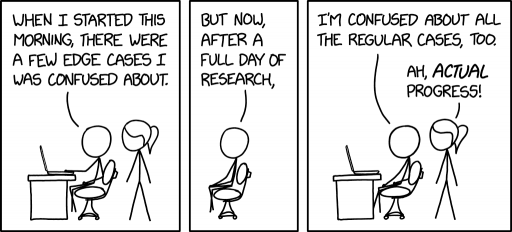Difference between revisions of "2797: Actual Progress"
m (→Transcript: duplicate word) |
(→Transcript: science in general) |
||
| Line 29: | Line 29: | ||
[[Category:Comics featuring Cueball]] | [[Category:Comics featuring Cueball]] | ||
[[Category:Comics featuring Ponytail]] | [[Category:Comics featuring Ponytail]] | ||
| + | [[Category:Science]] | ||
[[Category:Physics]] | [[Category:Physics]] | ||
Revision as of 18:25, 3 July 2023
| Actual Progress |
 Title text: Slowly progressing from 'how do protons behave in relativistic collisions?' to 'what the heck are protons even doing when they're just sitting there?' |
Explanation
| |
This explanation may be incomplete or incorrect: Created by a CONFUSED RESEARCHER - Please change this comment when editing this page. Do NOT delete this tag too soon. If you can address this issue, please edit the page! Thanks. |
Transcript
| |
This transcript is incomplete. Please help editing it! Thanks. |
- [Cueball is sitting on an office chair at a desk and has his hand on a laptop. Ponytail is standing behind him.]
- Cueball: When I started this morning, there were a few edge cases I was confused about.
- [Panel of just Cueball sitting on the office chair.]
- Cueball: But now after a full day of research,
- [Same scene as in the first panel, but Cueball has his hand on his lap.]
- Cueball: I'm confused about all the regular cases, too.
- Ponytail: Ah, actual progress!
Discussion
So true! If the outliers look weird, it's often because you've misunderstood something about the whole set. ProphetZarquon (talk) 17:11, 3 July 2023 (UTC)
It may be good to start to ask whether your nice obedient little line is just a coincidence in your testing data. 172.71.26.159 17:22, 3 July 2023 (UTC)
- By the time you've happily worked out why the strange exceptions aren't actually strange/exceptions, you realise that there's no real underlying reason that carefully regiments the 'clearly patterned' bits and that's just a pure artefact of data... 172.70.86.132 18:24, 3 July 2023 (UTC)
- Related: You have two numbers which are supposed to be same but differs. Sure there is small bug in computing one of them ... and sure you find it, fix it ... and the difference became about twice as big. -- Hkmaly (talk) 20:10, 3 July 2023 (UTC)
When I read it, helped also by the title, I thought at scientific research more than software engineering. So I felt the explanation slightly off - not sure if I am alone. Vdm (talk) 22:12, 3 July 2023 (UTC)
- For me it reminded me of something I was doing recently. Boiling down some text, within which were numeric values (allied to descriptors that related to what those numeric values were). Dealt with the the distinction between floating point and (intentionally, not just coincidentally) integer numbers in various places, but then had to deal with various other notations. The first surprise was negative small values (should have been ~0, perhaps, for 0<=x<MAX, but smudged and badly re-normalised before getting into my hands), then there was exponential notations (multiple types), and then there was a set like 4.30k, 8.05M, 5.46T, 8.12Qu, 3.67Qi (had to presume Short Scale was in use, despite being the more illogical version) which I only discovered by checking for word-boundary exceptions for values when checking there weren't any currency or unit-of-measure aspects I needed to be aware of. When I process what I've extracted a bit more, no doubt I'll find other things to add to my edge-condition checklist. But it's already been 'fun' getting past the hurdles I know about!
- Now, this isn't really what I think the comic is about (at its core, even if closely related), and I think the Explanation is a little too bloated/all-over-the-place at the momemt already so I won't try to add anything from this experience in there as well. Just recording my own prosaic tale of recent experience, which probably says more about my bad choice of source data than anything else... 172.70.86.73 07:12, 4 July 2023 (UTC)
- Agreed on the bloated explanation - I don't think the third paragraph is doing anything to explain the comic at all at the moment. 141.101.99.72 11:52, 4 July 2023 (UTC)
Such a common scenario. In code you often wonder once you isolate buggy behavior: Why does anything work at all? It is usually because another bug cancels out this bug for the common cases. Not entirely sure what two bugs cancelling eachother out would mean in the realm of particle physics :D 162.158.95.80 11:08, 5 July 2023 (UTC)
- In QFT applied to code, with the introduction of a photon, bugs and antibugs can be generated spontaneously, but then cancel each other out, producing a photon. This type of activity makes for virtual bugs and virtual antibugs.
